2018 年上海东华大学考博英语真题
_____
program.
D. specific
D. disabled
D. confident
D. tame
D. observation
B. filled in
B. turned in
B. infinite
C. ceaseless
D. delicate
B. civilize
C. curb
B. corrupt
C. conserved
B. flattered
C. fascinated
C. taken over
D. broken in
B. stationary
C. spacious
B. reservation
C. preservation
C. turned across
D. turned out
about the value of this research
Part I Vocabulary (10 points, 0.5 point each)
Directions: There are 20 sentences in this section. There are four words or phrases marked A, B,
C and D under each of the following sentences. Choose the one word or phrase that best completes
the sentence. Mark the corresponding letter on your Answer Sheet.
1. Many scientists remain
A.sceptical
2. If you want to go to the concert, you’ll have to make a _____, or there will be no tickets.
A. conservation
3. The mother was _____ when her son confessed he had robbed a store.
A. dismayed
4. The _____ judge accepted money to let the prisoner go unpunished.
A. committed
5. It took them several weeks to ______the wild horse.
A. cultivate
6. It is a common theme of many science fiction stories that the world may one day be ______ by beings
from the outer space.
A. run over
7. It ______ that the old woman she had been taking care of was indeed her own mother.
A. turned over
8. The discovery of new oil fields in various parts of the country filled the government with
_______hope.
A. eternal
9. We hope there will be a peaceful ________ to the new system.
A. transmission
10.It is _______ that women should be paid less than men for doing the same
A. abrupt
11. The young flower girl has been in town for only several months, but she seems to be _____with
everyone who comes to the store.
A. admitted
12. When the wealthy man died his illegitimate son _____half of his legacy.
A. retreated
13. I have said nothing like that. He intentionally _____ my ideas to achieve his personal ends.
A. revised
14. Travelers are advised to use traveler's checks, which provide a secure _____ to carrying all
the money in cash.
A. substitute
15. Most of the nations in the world are working in a collaborative effort to ___ hunger from the
world.
A. abandon
16. I just can't _____ how he managed to finish his report so soon. He said he was only halfway through
it yesterday!
A. figure out
17. The mayor was asked to give a rough _____ of the cost of the construction of the new bridge.
A. assessment
18. At last his firm was _____ up by a multinational corporation.
C. announcement D. estimate
C. contradicted
D. distorted
B. transition
C. transaction
C. withdraw
D. eliminate
B. accepted
C. admired
B. alternative
C. selection
B. displayed
C. declared
B. absurd
C. adverse
D. transformation
D. displacement
B. work out
C. look out
D. draw out
D. acquainted
D. claimed
kind of work.
D. addictive
B. distracted
B. diminish
B. evaluation
�
D. gulped
B.
expired
C. amended
B. devoured
C. swigged
A. swallowed
19. When he went to the airport for the ticket, Tom suddenly realized that his passport had ____
for half a year.
A. abolished
20. According to the report, the ____ of the epidemic was frightening in that country.
A. multitude
D. constrained
C. magnitude
D.
gratitude
B. altitude
Part II Cloze Test (15 points, 1 point each)
Directions: For each numbered blank in the following passage, there are four choices marked A, B,
C, and D. Choose the best one and mark your answer on your Answer Sheet.
‘Popular science’ books by pioneering scientists come in many varieties, but are almost always
21 waiting for. Such books would certainly be authoritative accounts of the subject matter. What
is more important, 22, is that they give the reader a really unique 23. The genre includes
straightforward expositions of a technical topic, an early example 24 the classic little book on
relativity by Einstein himself. More 25 ---- and perhaps 26 greater value, in the long 27 ---- one
has a 28 of essays on widely varying themes. These reflect, directly 29 indirectly, the motivations,
the compulsions, the stance, the personal scientific philosophy ---- 30 short, the credo ---- of
a great scientist, giving the reader 31 insight into the working of a first-rate mind in a manner
that even the best of biographies can only 32. Restricting oneself to examples 33 from physics and
34 areas, some wonderful examples of this class are Wigner ’ s Symmetries and Reflections,
Chandrasekhar’s Truth and Beauty, Feynman’s The Character of Physical Law, and Dyson’s 35 the
Universe.
21.
22.
23.
24.
25.
26.
27.
28.
29.
30.
31.
32
33.
34.
35.
A. different
A. however
A. character
A. being
A. important
A. with
A. ago
A. election
A. and
A. on
A. valuable
A. repeat
A. concerned
A. relating
A. Disturbing B Disturb
B. eager
B. by the way
B. thought
B. has being
B. special
B. for
B. time
B. collection
B. or
B. for
B. attractive
B. approximate
B. brought
B. relative
C. worth
C. unfortunately
C. enjoyment
C. has been
C. often
C. in
C. distance
C. deduction
C. not
C. in
C. particular
C. enhance
C. taken
C. relate
C. Disturbed
D. gratitude
D. to be exact
D. perspective
D. been
D. clear
D. of
D. run
D. induction
D. but
D. of
D. mysterious
D. discover
D. thought
D. related
D. Disturbance
Part III Reading Comprehension (30 points)
Section A (20 points, 1 point each)
Directions: In this part of the test, there are four short passages for you to read. Read each passage
carefully, and then answer the questions that follow. Choose the best answer A, B, C, or D and mark
the corresponding letter on your Answer Sheet.
�
Passage 1
In recent years, there has been a steady assault on salt from the doctors. Politicians also got on
board. "There is a direct relationship," US congressman Neal Smith noted, "between the amount of
sodium a person consumes and heart disease, circulatory disorders, stroke and even early death."
Frightening, if true! But many doctors and medical researchers are now beginning to feel the salt
scare has gone too far. "All this hue and cry about eating salt is unnecessary," Dr. Dustan insists.
"For most of us it probably doesn't make much difference how much salt we eat." Dustan's most recent
short-term study of 150 people showed that those with normal blood pressure experienced no change
at all when placed on an extremely low-salt diet, or later when salt was reintroduced. Of the
hypertensive subjects, however, half of those on the low-salt diet did experience a drop in blood
pressure, which returned to its previous level when salt was reintroduced."
"An adequate to somewhat excessive salt intake has probably saved many more lives than it has cost
in the general population," notes Dr. John H. Laragh. "So a recommendation that the whole population
should avoid salt makes no sense." Medical experts agree that everyone should practice reasonable
"moderation" in salt consumption. For the average person, a moderate amount might run from four to
ten grams a day, or roughly 1/2 to 1/3 of a teaspoon. The equivalent of one to two grams of this
salt allowance would come from the natural sodium in food. The rest would be added in processing,
preparation or at the table.
Those with kidney, liver or heart problems may have to limit dietary salt, if their doctor advises.
But even the very vocal "low salt" exponent, Dr. Arthur Hull Hayes, Jr. admits that "we do not know
whether increased sodium consumption causes hypertension." In fact, there is growing scientific
evidence that other factors may be involved: deficiencies in calcium, potassium, perhaps magnesium;
obesity (much more dangerous than sodium); genetic predisposition; stress." It is not your enemy,"
says Dr. Laragh. "Salt is the No. 1 natural component of all human tissue, and the idea that you
don't need it is wrong. Unless your doctor has proven that you have a salt-related health problem,
there is no reason to give it up."
36. According to some doctors and politicians, the amount of salt consumed ___
A.
B.
C.
D.
exhibits as an aggravating factor to people in poor health.
cures diseases such as stroke and circulatory disorders.
correlates highly with some diseases.
is irrelevant to people suffering from heart disease.
37. From Dr. Dustan's study we can infer that ______
A. a low-salt diet may be prescribed for some people.
B. the amount of salt intake has nothing to do with one's blood pressure.
C. the reduction of salt intake can cure a hypertensive patient.
D. an extremely low-salt diet makes no difference to anyone.
38. In the third paragraph, Dr. Laragh implies that _____
A. people should not be afraid of taking excessive salt.
B. doctors should not advise people to avoid salt.
C. an adequate to excessive salt intake is recommended for people in disease.
D. excessive salt intake has claimed some victims in the general population.
39. The phrase "vocal …… exponent" (Para. 4) most probably refers to ____
A. eloquent doctor.
B. articulate opponent.
C. loud speaker.
�
D. strong advocate.
40. What is the main message of this text?
A.
B.
C.
D.
That the salt scare is not justified.
That the cause of hypertension is now understood.
That the moderate use of salt is recommended.
That salt consumption is to be promoted.
Passage 2
Globalization is not just some passing trend. Today it is an overarching international system shaping
the domestic politics and foreign relations of virtually every country, and we need to understand
it as such.
As thoughtful people concerned about world affairs, our job is to pick up "globalization," examine
it from all sides, dissect it, figure out what makes it tick, and then nurture and promote the good
parts and mitigate or slow down the bad parts. Globalization is much like fire. Fire itself is neither
good nor bad. Used properly, it can cook food, sterilize equipment, form iron, and heat our homes.
Used carelessly, fire can destroy lives, towns and forests in an instant. As Friedman says:
"Globalization can be incredibly empowering and incredibly coercive. It can democratize opportunity
and democratize panic. It makes the whales bigger and the minnows stronger. It leaves you behind
faster and faster, and it catches up to you faster and faster. While it is homogenizing cultures,
it is also enabling people to share their unique individuality farther and wider."
Globalization has dangers and an ugly dark side. But it can also bring tremendous opportunities and
benefits. Just as capitalism requires a network of governing systems to keep it from devouring
societies, globalization requires vigilance and the rule of law. Anti-trust laws, the Securities
and Exchange Commission, labor unions, charities, the Federal Trade Commission, and countless other
agencies and organizations keep American capitalism in check. Similar transparent mechanisms are
needed to make sure globalization is a positive force in the world.
Globalization will always have cheerleaders who are blind to the destruction globalization can cause.
And it will always have strident opponents blind to the way globalization gives some people their
first opportunity to fulfill basic aspirations.
As with most issues, the majority of people will be in the middle. They will see globalization not
as something to worship or demonize. Instead, they will see it as something to mold, shape and manage
for the betterment of everyone.
41. What does the word “mitigate” in paragraph 2 most likely mean?
A.
B.
C.
D.
To alleviate.
A.
To slow down.
To omit.
To go faster.
42. Why does the author compare globalization as fire?
A.
B.
C.
D.
When used correctly, they both can sterilize equipment.
When used improperly, they both can destroy our life.
When worshipped, they both improve our life greatly.
When demonized, they both can be dangerous.
43. Why is globalization compared as capitalism in the passage?
�
A.
B.
C.
D.
They both require vigilance to keep them from devouring societies.
They both need Federal trade commission and labor unions.
They both need transparent mechanisms to operate properly.
Both A and B.
44. People who worship globalization usually _____ while people who demonize globalization usually
____.
A.
B.
C.
D.
see it as something to mold for the improvement of everyone; stand in the middle to mold,
shape and manage for the betterment of everyone
believe globalization can be shaped ; believe globalization has dangers and an ugly dark
side
believe globalization is a positive force in the world; believe globalization requires
vigilance and the rule of laws
see no destruction globalization can cause; can not see that globalization gives some people
their first opportunity to fulfill basic aspiration
45. Which of the following is not necessarily required to make positive use of globalization?
A.
B.
C.
D.
Tremendous opportunities and benefits.
Vigilance and the rule of law.
Transparent mechanisms.
Molding, shaping and management.
Passage 3
A Chinese study found that antibiotics can help prevent stomach cancer in people who carry a common
strain of bacteria known to cause ulcers. The study adds to the already strong evidence that
Helicobacter pylori bacteria can cause stomach cancer, a disease especially prevalent in Asia but
far less common in the United States. Still, experts said the findings do not solve the dilemma of
whether and how to treat carriers of the bacteria.
The study involved 1,630 men and women from Fujian Province in southern China. All were carriers
of H. pylori; hundreds of them already had precancerouslesions (癌变) at the outset of the study.
Patients were randomly assigned to receive two weeks of treatment with antibiotics and an anti-ulcer
drug, or a dummy medicine, and were followed for 7 years and a half after that. Among the 988 patients
without precancerous lesions at the outset, none on the treatment got stomach cancer, compared with
six in the placebo group.
The findings among those with precancerous lesions were not as clear-cut: Seven in the treatment
group developed stomach cancer, versus 11 in the placebo group. The study appears in Wednesday's
Journal of the American Medical Association. H. pylori is estimated to affect as many as 90 percent
of people in some developing nations and up to 50 percent of people in some industrialized countries,
according to the World Health Organization. Chronic H. pylori is thought to cause stomach cancer,
and doctors have come to believe since the early 1980s that it is the No. 1 cause of ulcers.
The findings suggest that doctors should consider routine screening for such lesions in H. pylori
patients in high-incidence areas, and treating the infections in patients with no precancerous lesions,
said the authors, led by Benjamin Chun-Yu Wong of the University of Hong Kong.
Dr. Michael Brown, a gastroenterologist at Rush University Medical Center in Chicago, said routine
H. pylori screening would not be cost-effective in the United States because the rates of infection
and cancer are so low.
�
46. According to the passage, experts in the Chinese study mentioned in the passage are still not
sure _______.
A.
B.
C.
D.
whether Helicobacter pylori bacteria can cause stomach cancer
whether stomach cancer is more prevalent in Asia
whether to treat all carriers of Helicobacter pylori bacteria
whether Helicobacter pylori bacteria can cause stomach ulcer
47. Among people who developed cancer in the study, proportion of patients in the treatment group
to patients in the placebo group is_____.
A.
B.
C.
D.
64%
50%
90%
39%
48. In the study, what medicine did the placebo group take during the two-week treatment?
A.
B.
C.
D.
Antibiotics.
A dummy medicine.
An anti-cancer medicine.
Medicine for the precancerous.
49. How many patients in the study already had precancerous lesions at the outset of the study?
A.
B.
C.
D.
1467
988
815
642
50. The findings of the study propose that ______.
A.
B.
C.
D.
H. pylori patients in high-incidence areas should be screened and treated.
patients with precancerous lesions are not as easily cured as those without.
treatment should be given to H. pylori patients without precancerous lesions.
treatment should not be given to H. pylori patients with precancerous lesions.
Passage 4
NASA’s Goddard Space Flight Center in Greenbelt, Maryland has been given the nod to lead a robotic
lunar mission in 2008
-- a key step in President George W. Bush’s recently announced space vision
strategy. The lunar reconnaissance orbiter would likely be geared to investigate the potential for
water ice trapped at the Moon’s poles. This type of investigation may involve powerful radar to
scan the always darkened craters, thought by some scientists to contain bountiful quantities of water
ice.
Water ice is believed to have been brought to the Moon by impacting comets. Both NASA’s Lunar Prospector
and the Pentagon’s Clementine spacecraft offered tantalizing data interpreted by some experts as
indicative of water ice deposits.
A number of alterative, fast-track approaches are under review at the Goddard Space Flight Center
(GSFC) to build the lunar orbiter. A newly formed GSFC lunar study team held their first meeting
Thursday to begin scoping out how best to move the project forward.
President Bush has directed NASA to undertake lunar exploration activities to enable sustained human
and robotic exploration of Mars and more distant destinations in the solar system. Starting no later
than 2008, the Bush plan calls for initiating a series of robotic missions to the Moon to prepare
for and support future human exploration activities. A follow-on robotic lunar lander is also slated
for 2009. The White House space directive states that the first extended human expedition to the
lunar surface could occur as early as 2015, but no later than the year 2020.
�
In reestablishing and reenergizing NASA’s Moon program, the White House envisions lunar exploration
activities to further science, and to develop and test new approaches, technologies, and systems,
including use of lunar and other space resources, to support sustained human space exploration to
Mars and other destinations.
51. On the robotic lunar mission which is to be led by NASA’s Goddard Space Flight Center, the lunar
orbiter _______.
A. would possibly investigate whether there is water ice at the Moon’s pole.
B. would announce the president’s space vision strategy to the whole world.
C. would likely extend human expedition to the lunar surface for the first time.
D. would offer tantalizing data interpreted by some experts as space resources.
52. On the robotic lunar mission, _____ will be explored to search for water ice.
A.
B.
C.
D.
impacting comets near the Moon
the darkened craters on the Moon.
a robotic lunar lander on the Moon
NASA’s Moon program
53. According to the third paragraph of the passage, why a newly formed GSFC lunar study team held
their first meeting on Thursday?
A.
B.
C.
D.
To build the lunar orbiter as soon as possible.
To move the NASA’s Moon programs forward.
To search for the best approach to build the lunar orbiter.
To discuss the scope the lunar orbiter is to explore.
54. Federal government of the U.S. states in its space directive that _______.
A.
B.
C.
D.
the first human landing on the lunar surface would occur no later than 2020
the first long-time human expedition to the lunar surface would occur in 2015
the first human extended expedition to the moon would occur before 2021
the first human survival on the lunar surface would occur no later than 2020
55. One of the purposes of NASA’s Series lunar exploration missions is to _____.
A.
B.
C.
D.
further investigate impacting comets that have brought water ice to the Moon
scope out how best to move the Pentagon’s Clementine spacecraft project forward
prepare for and support Goddard Space Flight Center (GSFC) to build the lunar orbiter
develop and test new technologies to support human space exploration to Mars
Section B (10 points, 2 points each)
Directions: In this section, there is a passage with five questions. After you have read the passage,
answer each question in English with no more than 15 words. Write down your answer on the Answer
Sheet.
Passage 5
Is Having a Home a Right?
Even on these coldest nights of the year, Americans can't claim a right to adequate housing - not
yet. But the notion that having a home is a basic human right is one that is gaining some currency
around the globe, as well as on the corners of some of the most frigid cities in the United States.
Record-breaking cold spells this winter have brought fresh attention to the plight of the 840,000
Americans who sleep in streets or in makeshift shelters on any given night. Twenty-five cities are
reporting an average 13 percent increase in requests for emergency shelter over 2002, according to
a US Conference of Mayors survey.
�
Arguing that housing is a basic human entitlement, some advocates for the homeless have sharply
criticized the situation in the US. Despite the country's enormous wealth, a growing number of its
citizens are homeless - a state of affairs that some international groups view as unacceptable and
unjust.
An investigator for the United Nations Commission on Human Rights in January cited the US for "a
range of violations" in a "dire reality" of "human rights denial" in the area of housing.
Homeless advocates have also cried foul. A January report from the National Law Center on Homelessness
and Poverty says US promises made in 1948, 1949, and 1996 to progressively house all its citizens
"have been badly broken." The Chicago Coalition for the Homeless, meanwhile, is preparing to argue
that a projected net loss of 8,000 public housing units over the next five years would, for as many
as 10,000 squatters, constitute unfair "forced eviction" under international human rights law.
"I think a lot of us are groping for ways to square local, state, and national law with human rights
principles," says Rene Heybach, director of the Chicago Coalition's Law Project. "There's a great
yearning to find an international focus because our government hasn't provided enough to keep our
people safe."
But changes are a foot, argue some members of the Bush administration.
"It may very well be," says Philip Mangano, executive director of the federal Interagency Council
on Homelessness and the government's point person on homelessness, that remedying "this wrong of
homelessness will lead us to establish the right to housing. That would be consistent with our history
of righting wrongs in this country, like slavery, and then creating rights afterward."
Mr. Mangano disputes the claim that the Bush administration has failed to address what he acknowledges
to be a problem exacerbated by simultaneous job losses and rising housing costs. He points to the
current year's $1.27 billion investment in a range of programs to reduce homelessness. The figure
marks a $100 million increase over the prior year, he said, and represents "probably the most ever
invested anywhere" to put the needy in homes.
The United States is not alone in experiencing a rise in homelessness, Mangano points out. And although
other countries, such as Scotland and France, have in recent years passed legislation toward housing
all citizens, the US is in his view honoring the spirit of its international pledges by funding programs
to stem the causes of homelessness.
56. Why do people pay more attention to the matter of homelessness?
57. What is a state of affairs that some international groups view as unacceptable and unjust?
58. Why does Rene Heybach, director of the Chicago Coalition's Law Project, say that there's a great
yearning to find an international focus?
59. According to Mr. Mangano, what factors probably contribute to the increase of the homeless in
America?
60. What countries have in recent years passed laws toward housing all citizens according to the
passage?
Part IV Error Detection and Correction (10 points, 1 point each)
Directions: Each of the following sentences has four underlined parts. These parts are labeled A,
B, C and D. Identify the part of the sentence that is incorrect and mark out your choice on the Answer
Sheet. Then, without altering the meaning of the sentence, write down your correction on the Answer
Sheet.
�
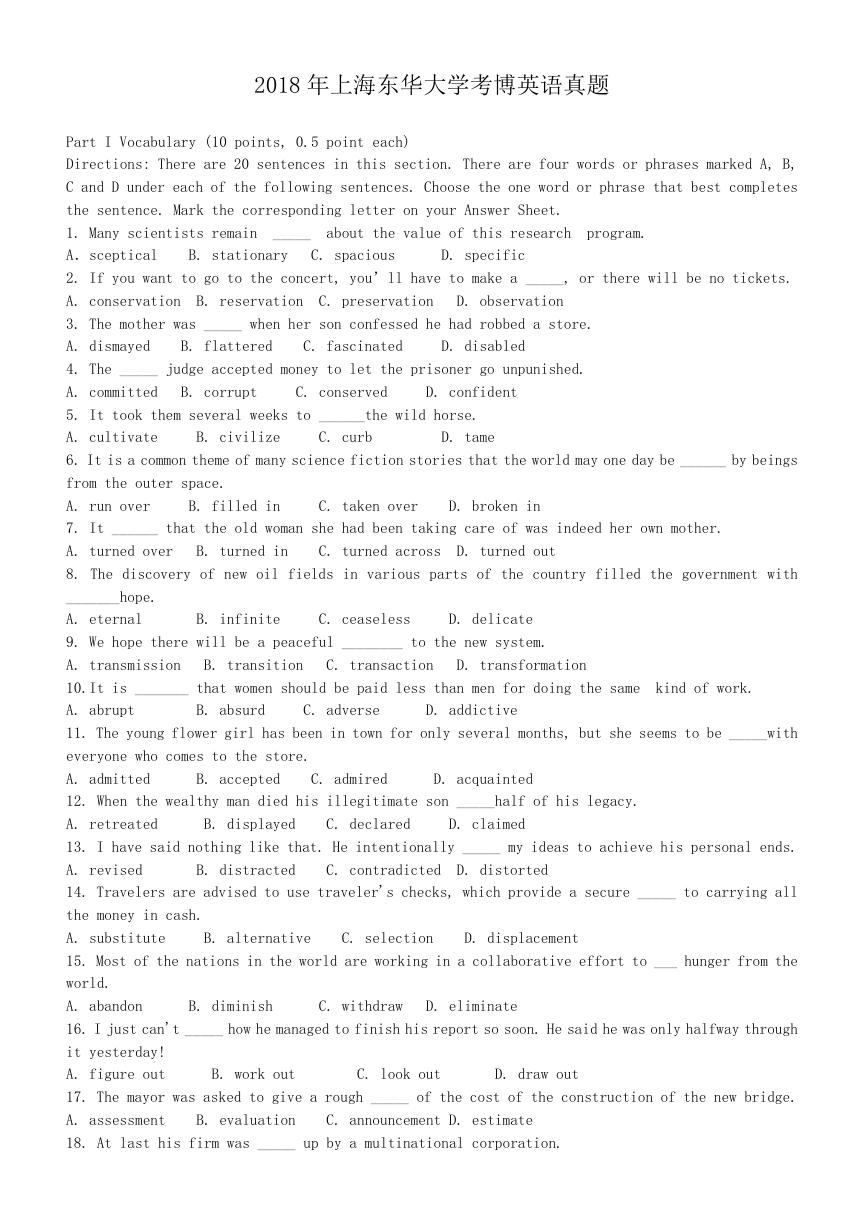

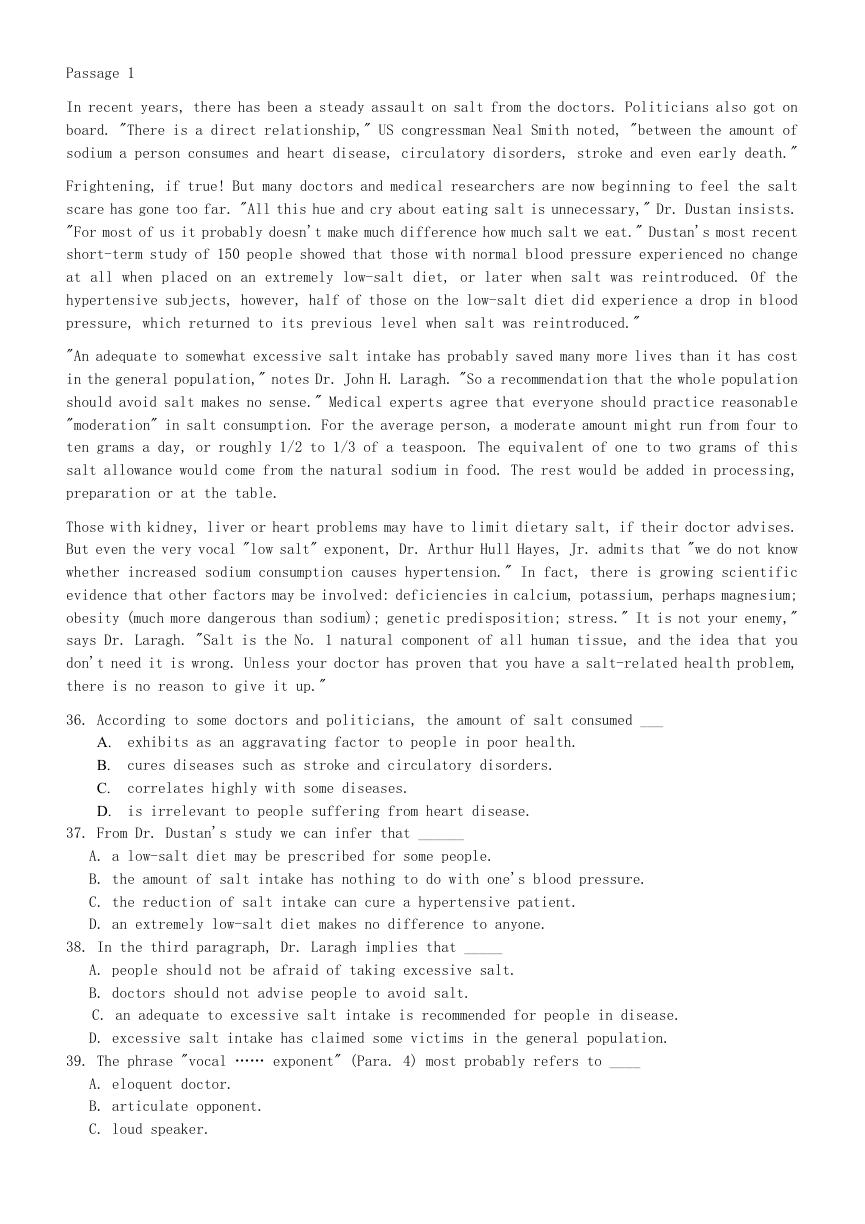
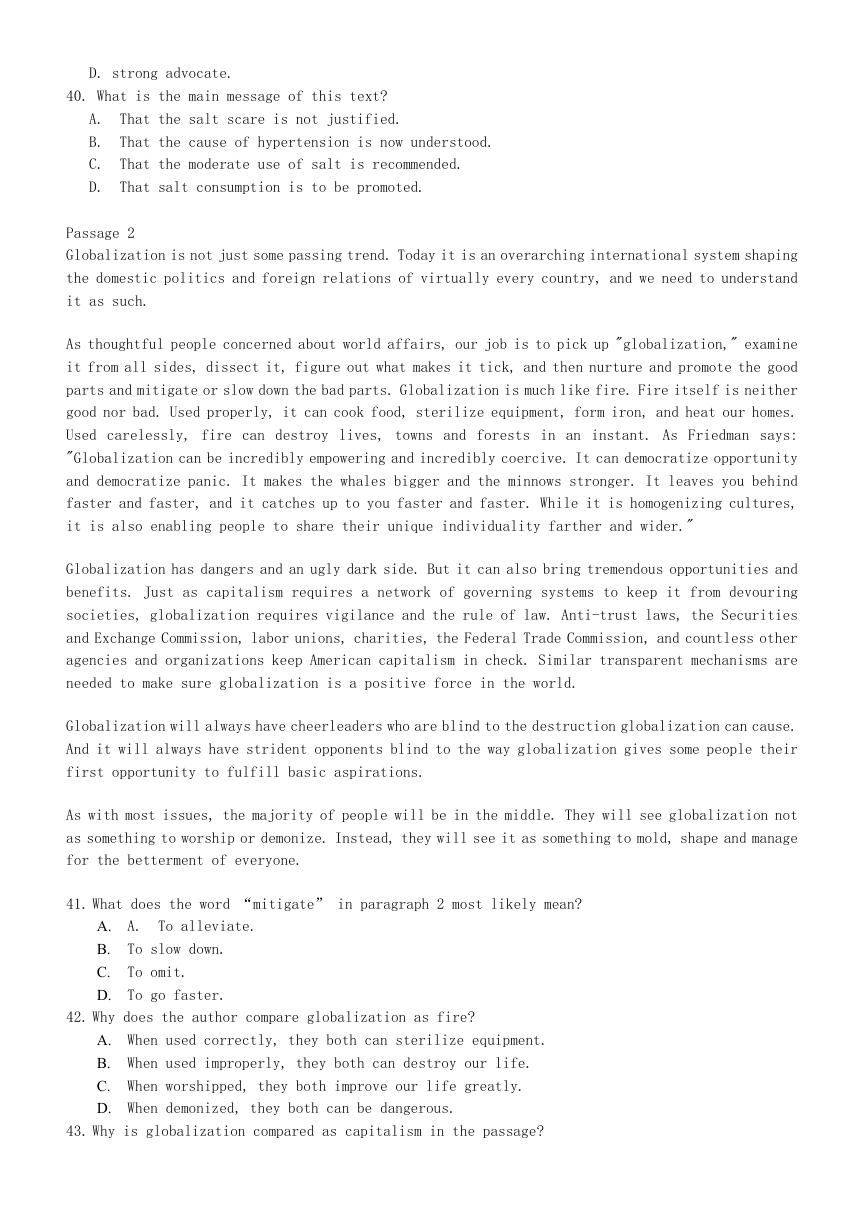
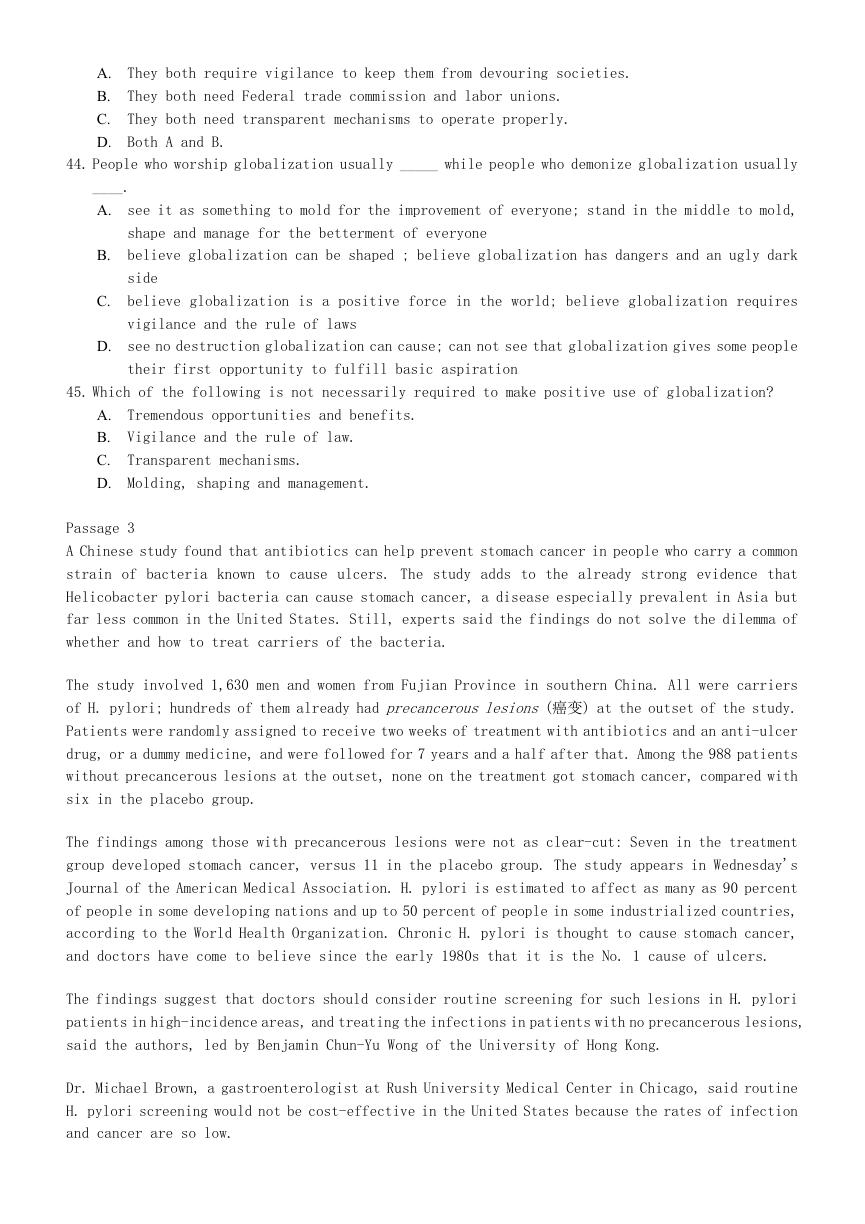
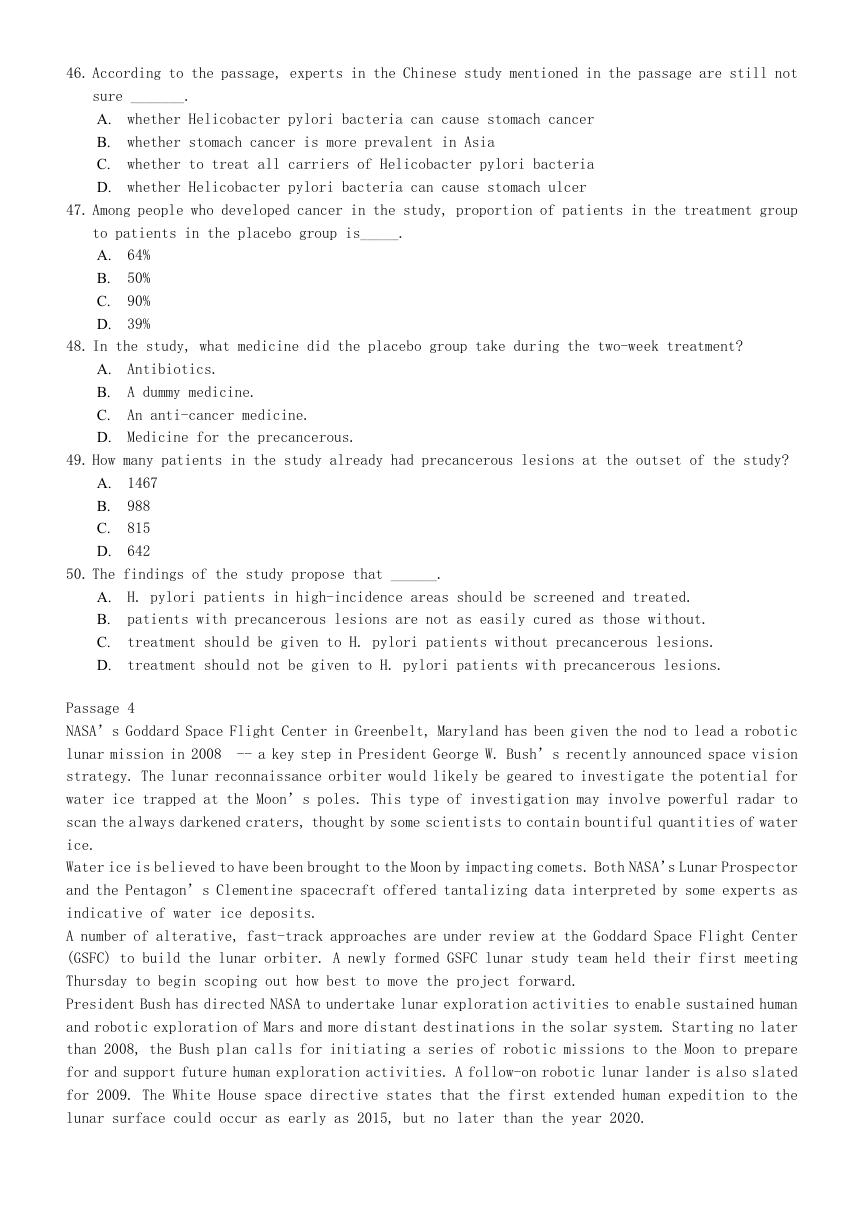
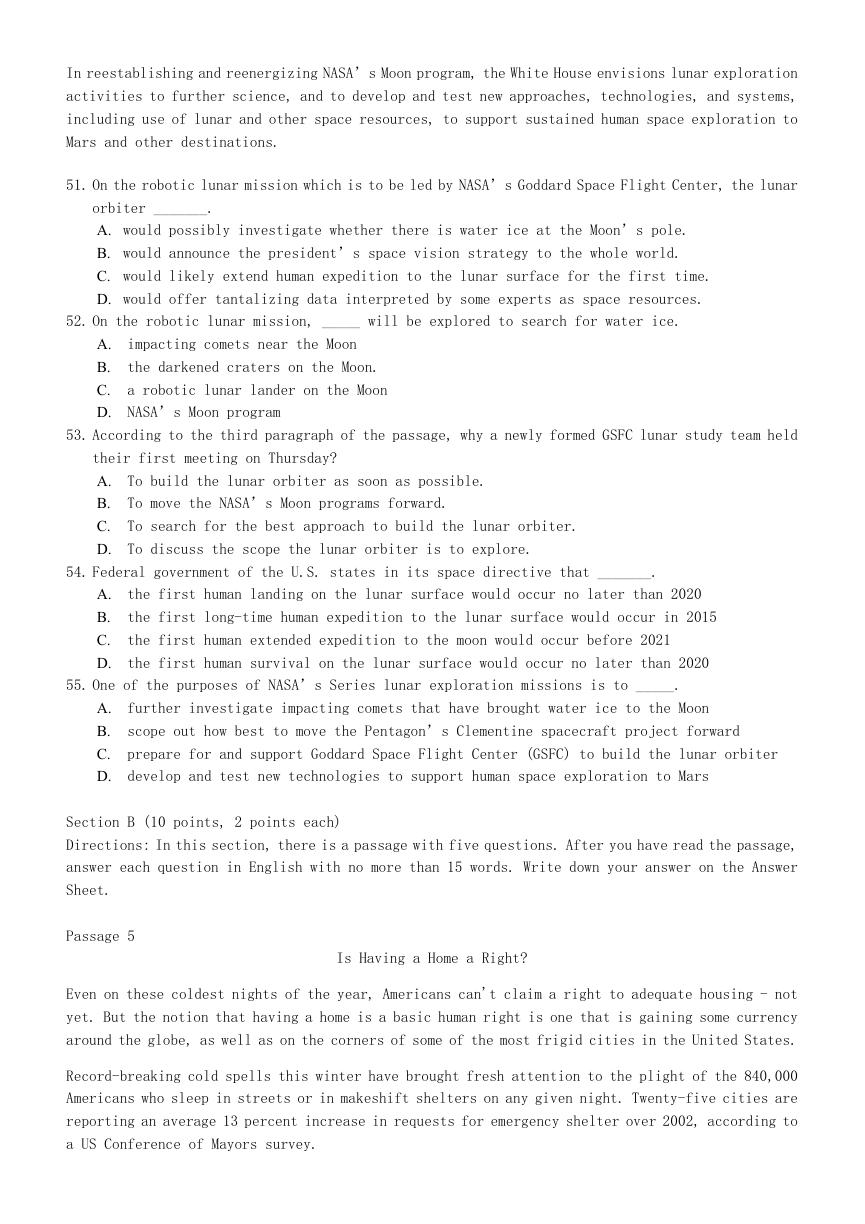
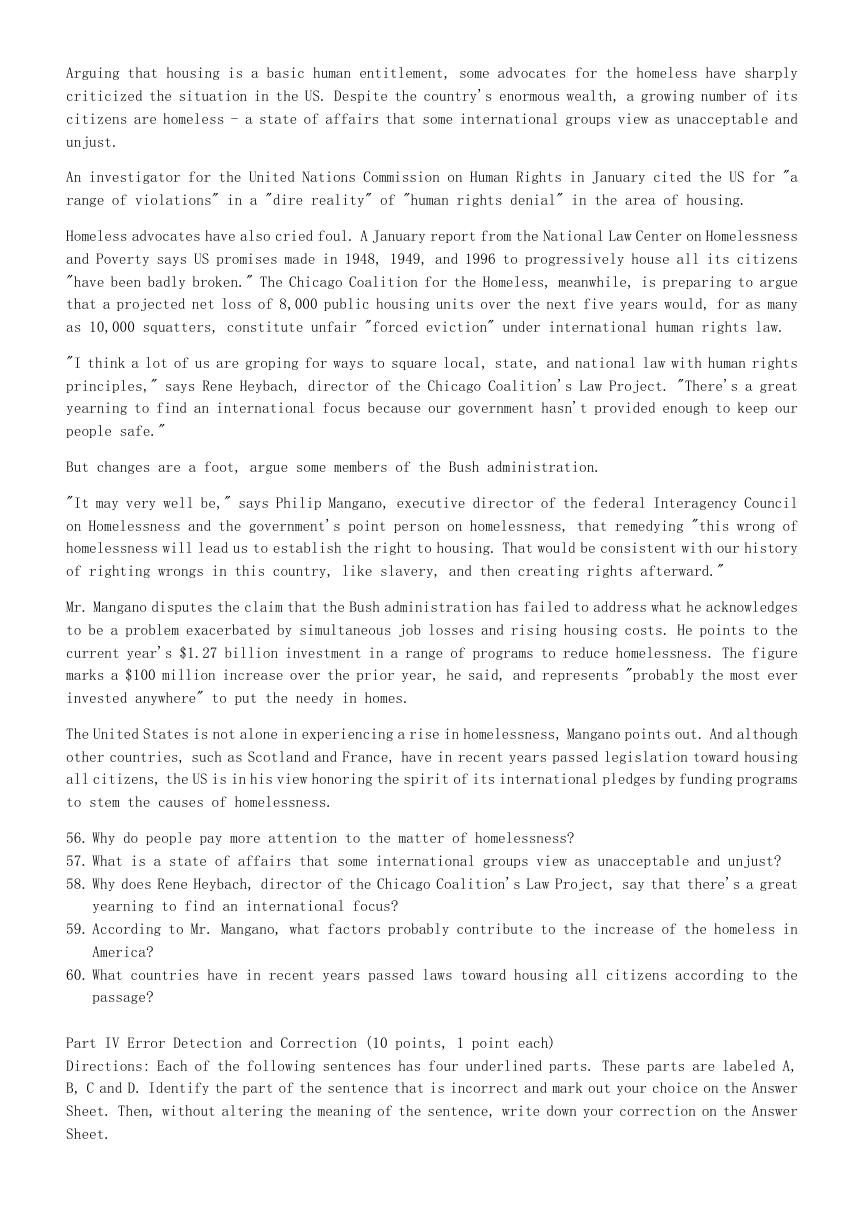








 2023年江西萍乡中考道德与法治真题及答案.doc
2023年江西萍乡中考道德与法治真题及答案.doc 2012年重庆南川中考生物真题及答案.doc
2012年重庆南川中考生物真题及答案.doc 2013年江西师范大学地理学综合及文艺理论基础考研真题.doc
2013年江西师范大学地理学综合及文艺理论基础考研真题.doc 2020年四川甘孜小升初语文真题及答案I卷.doc
2020年四川甘孜小升初语文真题及答案I卷.doc 2020年注册岩土工程师专业基础考试真题及答案.doc
2020年注册岩土工程师专业基础考试真题及答案.doc 2023-2024学年福建省厦门市九年级上学期数学月考试题及答案.doc
2023-2024学年福建省厦门市九年级上学期数学月考试题及答案.doc 2021-2022学年辽宁省沈阳市大东区九年级上学期语文期末试题及答案.doc
2021-2022学年辽宁省沈阳市大东区九年级上学期语文期末试题及答案.doc 2022-2023学年北京东城区初三第一学期物理期末试卷及答案.doc
2022-2023学年北京东城区初三第一学期物理期末试卷及答案.doc 2018上半年江西教师资格初中地理学科知识与教学能力真题及答案.doc
2018上半年江西教师资格初中地理学科知识与教学能力真题及答案.doc 2012年河北国家公务员申论考试真题及答案-省级.doc
2012年河北国家公务员申论考试真题及答案-省级.doc 2020-2021学年江苏省扬州市江都区邵樊片九年级上学期数学第一次质量检测试题及答案.doc
2020-2021学年江苏省扬州市江都区邵樊片九年级上学期数学第一次质量检测试题及答案.doc 2022下半年黑龙江教师资格证中学综合素质真题及答案.doc
2022下半年黑龙江教师资格证中学综合素质真题及答案.doc